AquaZone
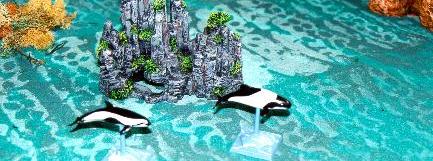
The Game of Deep Sea Exploration & Combat
AquaZone features underwater combat with submarines, DSV's and marine animals. It was meant as a light-hearted change from the 'serious' wargames, but everyone seemed to like it, especially because of the nice and original scenery.
However, we only played two games so far, both on the same evening. It was obvious that after these games, some of the rules needed some adjustment. The rules as presented on this page are the original rules I wrote, ans should therefore not be considered as 'very well balanced'. If you are setting up a similar game as AquaZone, please let us know so we can add a link to your page or include some of your comments on this page.
Inspiration & Ideas
The idea for running a game like AquaZone came primarly from an article in
an old issue of Practical Wargamer (May 1989). In that issue, some
simple rules were given to recreate underwater battles, based on the
television series Stingray. The article featured underwater combat
between DSV's, but also featured marine animals and a large nuclear
submarine. Most of the content of that article is now put online by John
Treadaway on this
page.
What really caught my attention were the beautiful pictures that accompanied the article. A few of them are reproduced here for your enjoyment. What was obvious, is that the look of the game is very attractive, and that you can achieve it by merely using some toys or some cheap stuff you can buy in any seaside shop. Since then, I've always wanted to run a similar game, but never actually did it, until 1998.
A second source of inspiration was the movie The Abyss. Apart from the somewhat supernatural plot, the movie also had some battlescenes between one-man sized DSV's. Of course, the televesion series SeaQuest DSV provided lots of additional ideas.
|
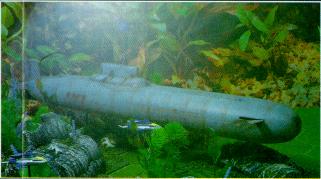
Two StingRays escort a nuclear submarine through hostile territory (Practical Wargamer 1989).
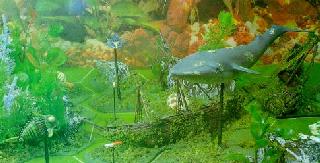
A TerrorFish fires a missile at a whale. A StingRay in the background fires back (Practical Wargamer 1989). Clicking the picture gives you a slightly larger image.
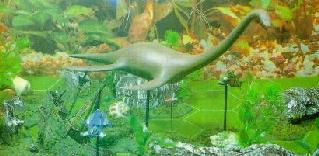
A StingRay and a TerrorFish fire missiles, while a Plesiosaur wonders what's going on. Note the shipwreck (Practical Wargamer 1989). Clicking the picture gives you a slightly larger image.
|
Pictures
It was of course very difficult to recreate the stunning pictures from Practical Wargamer, but we tried. The picture on the right is more or less the look we achieved. We used a SeaScape cloth from GeoHex, and added lots of lichen. We used Micromachines for the DSV's, and added some plastic marine animals. In the end, all players agreed that the final result was very good.
Take a look at our Picture Gallery if you want to see more AquaZone pictures!!!!
|
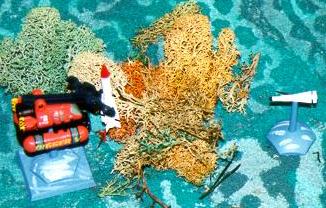
A DSV is transporting a nuclear warhead, unaware of the incoming missile.
|
Rules
Once we knew how to provide the scenery and to make the wargaming table visually attractive (that's what miniature wargaming is all about!), we had to find a set of rules that would allow us to recreate DSV encounters.
The rules we used were based on the excellent Full Thrust rules for simulating space combat, a ruleset known to us, and one we use very regularly. We reused the maneuvring rules and the damage rules, and we added some rules for ramming attacks and missile attacks.
The outline below gives a short overview of the rules we used during our games. Unless noted otherwise, the standard rules from Full Thrust apply.
General rules
- Maximum speed for DSV's and animals is 12.
- Maximum speed for missiles is 16.
- Shields are now called Hull Armour.
- If critical damage is reached, roll for each system as per Full Thrust. New systems include crewmembers, launch tubes, and missile racks.
Ramming Attacks
- If you want to ram a target, you have to write this in your order.
- The ramming vessel or creature should end within 4" of its intended target.
- Ramming is succesful if D6+thrust attacker exceeds D6+thrust defender.
- Damage due to ram attack is determined by a number of D6. The number of D6 is equal to the number of damage rows of the opponent. Hull armour is taken into account to consider the damage inflicted. Use the following damage table:
- no armour: 1-3: 1 damage; 4: 2 damage; 5: 3 damage; 6: 4 damage
- 1 armour: 1-3: 0 damage; 4: 1 damage; 5: 2 damage; 6: 3 damage
- 2 armour: 1-4: 1 damage; 5: 1 damage; 6: 2 damage
- 3 armour: 1-5: 1 damage; 6: 1 damage
Missiles
- It takes 1 turn to load or unload a launch tube. This must be part of the order. The type of missile (guided or heat-seeking) is part of the order must be specified. There is a limited number of missiles available on each DSV.
- Firing of missiles takes pace in the fire phase. Upon launch, a speed for the missile is chosen. This speed is maintained during the life cycle of the missile. The missile moves straight ahead when it is launched, but cannot hit anything this turn.
- Guided Missiles: these are moved AFTER writing orders, but BEFORE vessels are moved. They move at their initial speed, and can make one turn, upto 60 degrees, in the middle of their movement. Guided missiles explode if they end their move within 6" of any ship. Damage is applied to all vessels within 6". 4D6 per target are rolled.
- Heat-seeking missiles: These are moved AFTER ships are moved. They can turn upto 45 degrees at the beginning of their move. They turn to the nearest target within this arc and then proceed straight ahead. If the missile reaches its target, the missile detonates on a 3+ on a D6; damage is applied immediatly (4D6). If the missile does not detonate, it passes the target and searches for a new target next turn.
- Missiles stay active during 3 turns, not counting the turn in which they are launched.
- Damage for missiles:
- no armour: 1-3: 1 damage; 4: 2 damage; 5: 3 damage; 6: 4 damage
- 1 armour: 1-3: 0 damage; 4: 1 damage; 5: 2 damage; 6: 3 damage
- 2 armour: 1-4: 1 damage; 5: 1 damage; 6: 2 damage
- 3 armour: 1-5: 1 damage; 6: 1 damage
Crew
- Each DSV has a number of crewmembers, indicates by the little smileys.
- At the end of each turn, each crew member may try to repair one system on board. This succeeds when a 6 is rolled on a D6. Other crew cannot be 'repaired'.
- If a vessel has no crew left, it is out of action.
Templates
These gif-files are templates for various DSV's and marine animals we used. Each DSV has a number of crew, 2 launch tubes, and a number of missile racks (heat-seekers and guided).
Options
It is of course straightforward to add rules for mines, giant monsters etc. However, we first wanted to see how the 'basic' game worked before adding it all kinds of extra weaponry. We did have a giant squid though, who tried to reach out several times to catch a DSV or animal in one of its tentacle arms.
Scenarios
It's very easy to come up with good and fun scenarios. The simplest is of course a straight encounter between opposing DSV's, where only surviving counts.
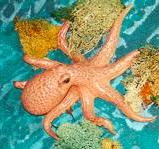 In our two games we played, we had two opposing sides: the DEEP SEA EXPLORATION COMPANY, who wanted to exploit the oceans, and the AQUANAUTS, who were trying to protect the environment. In the first game, the AQUANAUTS tried to rescue a rare animal (it was a stingray), while the DSEC tried to capture it. Both sides tried to 'push' the animal to their side of the board. If you were within 6" of the stingray, he moved 2D6" directly away from you, regardless what orientation he was in. So, you had to try to get behind the animal to herd it to your side of the table. If no-one was close, he just moved in a random direction.
In our two games we played, we had two opposing sides: the DEEP SEA EXPLORATION COMPANY, who wanted to exploit the oceans, and the AQUANAUTS, who were trying to protect the environment. In the first game, the AQUANAUTS tried to rescue a rare animal (it was a stingray), while the DSEC tried to capture it. Both sides tried to 'push' the animal to their side of the board. If you were within 6" of the stingray, he moved 2D6" directly away from you, regardless what orientation he was in. So, you had to try to get behind the animal to herd it to your side of the table. If no-one was close, he just moved in a random direction.
A second scenario involved a sunken submarine. The AQUANAUTS wanted to retrieve a nuclear missile, to prove that the DSEC was using nuclear warheads to explore the oceanbed. DSEC, of course, wanted to prevent this.
Scenery
This picture gives an impression how we made our underwater game visually attractive by using the right type of scenery.
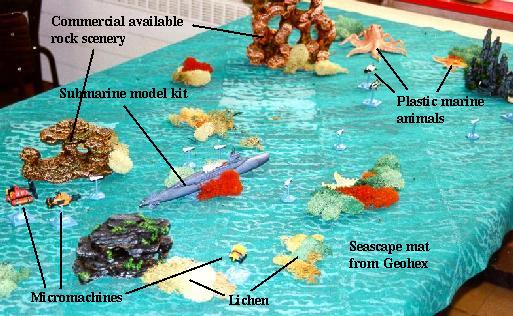
Links
The original Stingray game has a page here. Heartily recommended!
Since we put this page online, some other wargamers have reported their AquaZone adventures. If you have some material to share, please let us know!
- Depth Factor, a similar effort using Full Thrust for underwater warfare.
And for sheer inspiration:




 In our two games we played, we had two opposing sides: the DEEP SEA EXPLORATION COMPANY, who wanted to exploit the oceans, and the AQUANAUTS, who were trying to protect the environment. In the first game, the AQUANAUTS tried to rescue a rare animal (it was a stingray), while the DSEC tried to capture it. Both sides tried to 'push' the animal to their side of the board. If you were within 6" of the stingray, he moved 2D6" directly away from you, regardless what orientation he was in. So, you had to try to get behind the animal to herd it to your side of the table. If no-one was close, he just moved in a random direction.
In our two games we played, we had two opposing sides: the DEEP SEA EXPLORATION COMPANY, who wanted to exploit the oceans, and the AQUANAUTS, who were trying to protect the environment. In the first game, the AQUANAUTS tried to rescue a rare animal (it was a stingray), while the DSEC tried to capture it. Both sides tried to 'push' the animal to their side of the board. If you were within 6" of the stingray, he moved 2D6" directly away from you, regardless what orientation he was in. So, you had to try to get behind the animal to herd it to your side of the table. If no-one was close, he just moved in a random direction.
